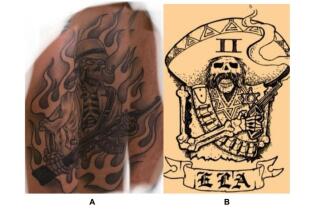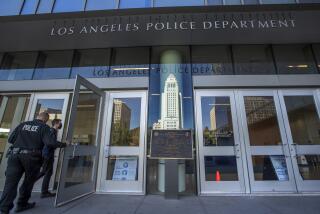Deputy who shot, stomped a downed suspect can be sued for excessive force, appeals court rules

WARNING: Graphic content. Dashboard camera video released by the U.S. 9th Circuit Court of Appeals shows an Orange County sheriffâs deputy shooting and stomping on a suspect in 2013.
An Orange County sheriffâs deputy who in 2013 continued to shoot a felled suspect and then stomped his head may be sued for using excessive deadly force, a federal appeals court decided Wednesday.
âWhen police confront a suspect who poses an immediate threat, they may use deadly force against him,â Judge Alex Kozinski wrote for a unanimous three-judge panel of the U.S. 9th Circuit Court of Appeals. âBut they must stop using deadly force when the suspect no longer poses a threat.â
In an unusual action, the court released the police videos of the fatal shooting, which can be viewed here and here. The shooting occurred three minutes into the first video and 3½ minutes into the second.
The court reached its decision in a lawsuit filed by the mother of Connor Zion, 21, who suffered seizures, bit his mother and cut her and his roommate with a kitchen knife, according to the court.
The Sheriffâs Department was called. When Deputy Juan Lopez arrived at the condominium complex in Laguna Niguel, Zion ran toward him and stabbed Lopezâs arms.
Deputy Michael Higgins, who arrived separately and saw the attack, shot Zion.
Video on the department dashboard cameras revealed that Higgins initially fired nine shots. Once Zion was on the ground, Higgins fired nine more times, emptying his gun.
Then Higgins walked in a circle, took a ârunning startâ and stomped on Zionâs head three times, the court said the video showed.
The Sheriffâs Department later awarded Higgins a medal of valor for the action for saving his partnerâs life, the Orange County Register reported.
Zion appeared to have been wounded and was not making threatening gestures after being fired upon at ârelatively close rangeâ and falling to the ground, the court said.
âWhile Higgins couldnât be sure that Zion wasnât bluffing or only temporarily subdued, Zion was lying on the ground and so was not in a position where he could easily harm anyone or flee,â Kozinski wrote.
A jury could find that Zion did not pose an immediate threat and that Higgins should have held his fire, the court said.
âOr, a jury could find that the second round of bullets was justified, but not the head-stomping,â Kozinski wrote.
The Sheriffâs Department argued that Zion remained a threat on the ground because he was still moving.
âBut terminating a threat doesnât necessarily mean terminating the suspect,â Kozinski said.
If a suspect is on the ground and appears wounded, âa reasonable officer would reassess the situation rather than continue shooting,â the court said.
The Constitutionâs due process clause protects against such âbrutalâ conduct as head stomping, the court said, noting the strikes to Zionâs head appeared to be âvicious blows.â
âLike forced stomach-pumping, head-stomping a suspect curled up in the fetal position âis bound to offend even hardened sensibilities,ââ Kozinski wrote, citing a previous ruling.
The decision revived the lawsuit filed by Kimberly Zion, the dead manâs mother. A district judge had ruled for the Sheriffâs Department.
Twitter: @mauradolan
More to Read
Sign up for Essential California
The most important California stories and recommendations in your inbox every morning.
You may occasionally receive promotional content from the Los Angeles Times.











